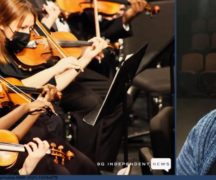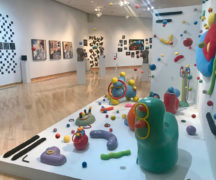By DAVID DUPONT
BG Independent News
The School of Art at Bowling Green State University is changing by degrees.
Last week the faculty senate gave unanimous approval to a change in the school’s core degree, the Bachelor of Fine Arts. Until now students have received their BFA in either two-dimensional art – drawing, painting, photography and printmaking – or three-dimensional art – sculpture, glass and ceramics.
If approved by the university’s Board of Trustees later this spring, the school will offer just one BFA, regardless of discipline. That is just one change of several that marks a shift in philosophy in the school, said interim director Charles Kanwischer. “This is a big step for the school.”
“We are a collection of disciplines. … We’ve been pretty good about maintaining the autonomy of those disciplines and giving students and faculty a lot of independence within them.”
But forces are pushing them together, he said.
For one, the media are blending together. Kai Lee Liu, the student who won best of show honors at the recent Undergraduate Exhibit, won the top prize with an installation that employed video with glass sculptures. Another of her pieces, which was also honored, was a sculpture made of ceramics that included a recording of the artist reading a poem. The disciplines “are bleeding together,” Kanwischer said.
Enrollment in the traditional disciplines is declining, a trend seen nationwide. At the same time more students were enrolling to study digital art and graphic design. The changes do not affect the BFA in Graphic Design nor BFA in Digital Arts.
The enrollment in the school is actually up. The change in degrees will give students greater flexibility as well as a more early exposure to the traditional disciplines. In the past, depending on what track students followed, they took introductory courses in three of four disciplines, now they will take introductory courses in five of the eight traditional disciplines – painting, drawing, printmaking, photography, metals and jewelry, glass and ceramics.
“We’re giving students more choice across those disciplines,” he said. The change also increases the number of credits in art courses to get a BFA from 73 to 75. That brings in school in line with accreditation requirements.
The change in the BFA, though, is just one. The changes in studio art requirements applies to those who receive a BFA in Art Education. They also received either a 2-D or 3-D degree, depending on their studio work. Those degrees are merging.
Barbara Bergstrom, who chairs the art education division, said the changes also will allow art education majors to concentrate in digital art and graphic design.
Also, the school is instituting three new art minors: art education, digital art, and photography.
Bergstrom said that the art education minor is open to students outside the School of Art. While open to all majors, to date most of the response has come from the College of Education and Human Development, particularly early education majors.
She sees the new minor as useful for those interested in community art education, working with the elderly or in nursing home settings or for arts commissions. She hopes the minor will lead to a BA in art education. This would also be for those in community art education, who want art training but don’t need to go through the rigors of getting K-12 teaching certification.
The other two minors also are open to students in all majors. Both are in high demand field.
Photography, said Lynn Whitney, who teaches photography, is applicable to a range of fields including American Cultural Studies, philosophy and biology. “Photography is in everybody’s hands. It just makes sense students would want to know more about it,” she said.
The minors represent a change in philosophy in the School of Art, Kanwischer said. Traditionally the focus of the school was on the BFA program. These were students who came with the aim of becoming professional artists. “The landscape has changed. Fewer students want to go into art; fewer students want to go into traditional disciplines.”
Now the school is looking outward to see how it can serve the university as a whole. “We have to rethink our mission,” he said. “We want that kind of diversity in our programs. We would like to have a physics student or an English student or a theater student taking photography. … It really connects to the mission that the school is open and available and having an impact in the community.”
Getting to this point was not easy, he said. The discussions were contentious. He credited Whitney employing the diplomacy needed to bring the changes to fruition.
These minors are just a start, he said. Others are possible, including a program in narrative art. Already students in creative writing are heading down that avenue. Kanwischer said a collaboration along those lines would be exciting.
“Everything is on the table right now,” he said. “Things are bubbling up, and people are bringing things to us. We’re open in a way we haven’t been.”
BGSU School of Art sees new role for itself





